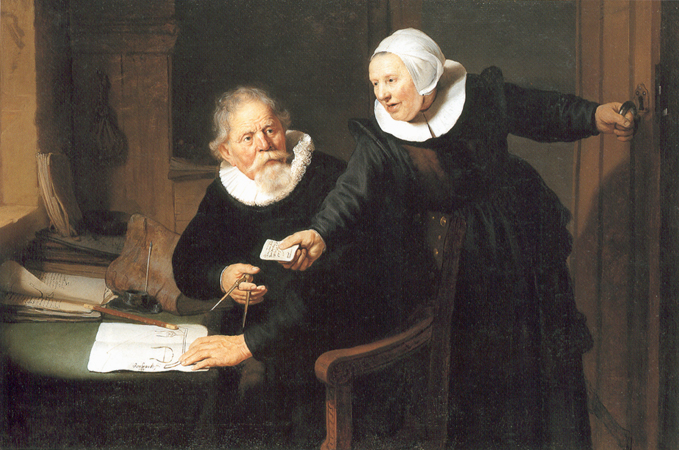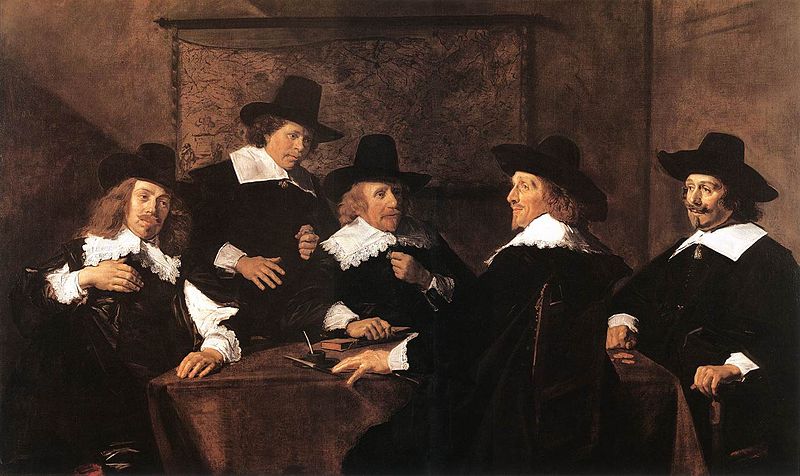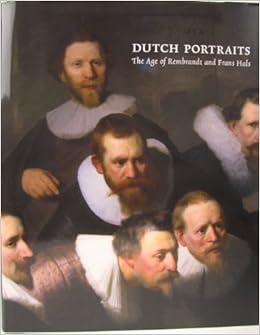In the autumn of 2007 the Mauritshuis presented a large survey exhibition of one of the most fascinating phenomena in the history of Western art: Dutch seventeenth-century portraiture. Nowhere else were so many portraits painted of burghers from all walks of life. Amazingly, the last exhibition devoted to this subject took place more than 50 years ago. With approximately 60 masterpieces, the exhibition afforded a magisterial overview of seventeenth-century portraiture. The two grand masters of the genre are Rembrandt and Frans Hals, both of whom are represented by at least eight masterpieces each. In addition, one or more works by some 25 other masters were also on view. The number of talented painters in the Northern Netherlands in the seventeenth century was unparalleled.
The exhibitionwas jointly organised with the National Gallery in London, where it was on view in the summer of 2007. The loans come from more than 30 different museums and private collections in Europe and the United States. Particularly important lenders are the Royal Collection in London, the National Gallery of Art in Washington, the Alte Pinakothek in Munich, the Gemäldegalerie in Berlin, the Musée du Louvre in Paris and the Gemäldegalerie in Kassel.
Timeless
Portraits have been painted since time immemorial. A growing interest in painted portraits on the part of the Dutch began to emerge around 1400. At the beginning of the seventeenth century citizens gained ever more power and influence, whereby their interest in luxury products also grew. Our ancestors were justly proud of their accomplishments and gladly and repeatedly had their likeness painted. Therefore, it is not surprising that portraiture became the most widely practiced artistic genre in the Northern Netherlands in the seventeenth century. One or more portraits were found in many households. Painters such as Frans Hals, Rembrandt, Thomas de Keyser, Johannes Verspronck and Nicolaes Maes were granted the commissions and fared well.
Best foot forward
Portraits were always painted on commission. Often the sitters’ names are still known to us today, and we have information about them. Moreover, much can be discerned in the paintings themselves. The clothing, jewellery, and hair styles all indicate how fashionable or wealthy the person portrayed was. A confident gaze, a bold pose, a roguish smile or a striking goatee all express something about an individual’s personality or character, while an attribute or a coat of arms discloses more about the sitter’s background or profession. And this is what continues to engage us now. Who exactly are we face to face with? Obviously, people wanted to show their best side in a portrait. Rembrandt’s phenomenal Portrait of an old man from 1667, however, constitutes an exception to this rule. We see a slumped over, informally dressed man who seems unaware of the painter observing him. Despite having been made centuries ago some paintings make a very contemporary impression. They could almost be the faces of people you might encounter at any street corner on any given day.
Precious memories
The reasons for commissioning a portrait in the seventeenth century actually differ very little from those today. Still now, and perhaps even more so, we have portraits made of ourselves, the people we love and our children either to hang at home or to give as presents. A painted or photographed portrait is a precious keepsake of a person, a special moment or a specific phase in one’s life, but chiefly a sign of love and appreciation. In the seventeenth century an important appointment often called for the making of an individual or a group portrait. However, portraits were not just about enhancing one’s standing or status. Women and children were also recorded on canvas in intimate ‘family snapshots’. Naturally, a marriage was a festive occasion for ordering a (double) portrait. Group portraits were less private in character and generally made to mark the entrance of a new board of regents of a charitable institution, guild or other governing body.
Alone, the two of us, or everybody
A fine example of an individual portrait is
Hals’ 1645 Portrait of Willem Coymans
in the National Gallery of Art in Washington. His likeness is, as it were, a snapshot of a moment in time in the life of a young merchant, who - with his long, loose and curly hair - reflects the elegant nonchalance of the fashion of the new generation.
Portraits of married couples or of a family were often produced as pendants, two paintings next to one another. A lovely example of this is the
early portrait pair from 1602 of a couple from Hoorn and their children by Jan Claesz:
Portrait of Albert Sonck and his Son Frans
Portrait of Lysbeth Walichsdr and her Daughter Elisabeth
A double portrait represented an additional challenge to the portraitist. One of the most successful compositions in this genre is the
1633 Double portrait of Jan Rijcksen and his wife Griet Jans by Rembrandt
in the Royal Collection in London. Wonderfully depicted here is the moment when the shipbuilder looks up at his wife while she hands him a letter.
Family portraits (for instance, by Jan Molenaer) are particularly valuable and interesting because they afford a glimpse into how wealthy individuals decorated their homes in the seventeenth century. Portraits of children, like those by Jacob Cuyp, Jan Steen and Salomon de Bray are not only touching but also reveal something about the position of children at the time as well as the relationship between parents and children.
A clear development can be traced in group portraiture. In early such portraits, the sitters are positioned next to and above one another in a rather static fashion. In this respect, Rembrandt’s earliest group portrait,
The Anatomy Lesson of Dr Nicolaes Tulp from 1632
is quite innovative. This masterpiece instantly catapulted him to the top of his profession making him the most desirable portraitist in the Dutch Republic.
Regent pieces are group portraits of governors of charitable institutions (hospitals, orphanages, or almshouses) that were hung in public places in the seventeenth century. These perfectly illustrate the organised nature of society in The Netherlands, evidencing concern and care for one’s fellow man and the formal structures of the various institutions.
The regents and regentesses of the
Amsterdam Crossbowmen’s Civic Guard (Bartholomeus van der Helst)
and of the
Haarlem St Elizabeth Hospital (Frans Hals),
among others, were on view at the exhibition.
Catalogue
Dutch Portraits: The Age of Rembrandt and Frans Hals is written by Rudi Ekkart and Quentin Buvelot, with contributions by Marieke de Winkel, Axel Rüger, Peter van der Ploeg, Ariane van Suchtelen and Lea van der Vinde. In this accessible publication all of the paintings on view are illustrated in colour and provided with an explanation. This is preceded by three richly illustrated essays treating the development of the painted portrait in the Northern Netherlands and aspects of the clothing and fashions depicted in the paintings.







